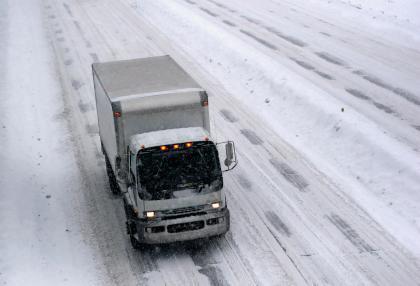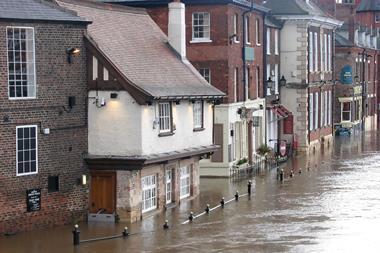Snow, ice and plunging temperatures in recent weeks has been a stark reminder to insurers of the threat from extreme weather. With the floods of 2009 still fresh in the memory, what lessons has the UK industry learned?

As the UK was plunged back into the freezer last week, with temperatures hitting lows of -12˚C in parts of England, insurers were not only bracing themselves against the bitter cold. The freezing weather raised the threat of yet another surge in weather-related losses. Claims for snow, ice and water damage last winter exceeded £1.4bn and 1.5 million homes were affected, according to the ABI.
With this following an increase in the incidents of severe flooding over the past decade, peaking with the devastating floods of 2009, have lessons about extreme weather been learned by both insurers and the insured? We assess the UK’s preparedness to deal with what the weather may throw at us next.
First, to gauge what the insurance industry is facing in terms of claims terms right now, the winter of 2011/12 began mildly in Britain. The average temperature in December 2011, for example, was 12.7˚C, whereas in December 2010 it was -1˚C, the coldest since Met Office records began in 1910. But the recent cold snap looks likely change the picture. Loss adjuster QuestGates director Simon Jones says: “We have seen a spike in burst pipe claims in the last two weeks.” The gales in early January will further add to average claim levels for this winter.
For example, Swiftcover saw claims spike by 250% on 3 January, according to personal finance website Myfinances. The insurer estimates that the average cost of a claim was almost £1,000 and says that most were for water damage and damage to conservatories and roofs.
The danger is that if the present cold snap continues, this will be too much for insurers”
Mohammad Khan, PricewaterhouseCoopers
The motor market took a hit in January too. AA Insurance spokesman Ian Crowder says: “Vehicles can be affected by severe weather. Floods can ruin vehicles and we’ve seen claims for hailstones the size of golf balls denting cars.” In line with this, the AA found that the storms during the first five days of 2012 brought a 28% rise in car insurance claims compared with the same period last year. The broker reported, among a wide variety of claims, a high incidence of damage wreaked by airborne trampolines.
The AA recorded 991 claims over the period, which it says suggests, based on its market share, that the wider industry will have seen more than 5,600. However, these events alone are unlikely to create more claims than the industry can handle. Aviva underwriting director Simon Warsop says: “The weather so far this winter has not been outside what we would expect.”
But what if the unexpected occurs, as it did over the last two winters? PricewaterhouseCoopers insurance partner Mohammad Khan says: “The danger is that if the present cold snap continues – say for a month, as some forecasters are predicting – this will be too much for insurers. We’ll see another surge in winter claims in March and that will be beyond what insurers were expecting.”
Damage limitation
With the threat of further severe weather a distinct possibility this year, it’s worth looking at just how much damage – and therefore insurance claims – could occur.
The good news is that the UK has become better at combating extreme weather. For one, many of the pipes prone to bursting will have done so by now during the past couple of big freezes Aviva’s Warsop says: “These will have been replaced with more up-to-date pipes, which are significantly less likely to burst.” Encouragingly, building regulations have increased the levels of insulation recommended in new buildings, while works to existing properties (in roofs, walls, floors, ceilings and so on) mean pipes across the country are becoming increasingly better insulated. On the other hand, Jones warns that a consequence of increased internal insulation can be that the roof stays extremely cold, which can lead to pipe bursts. However, “in modern housing, usually, pipes in the roof are themselves insulated, so this is not such a big risk”.
Less positively perhaps, the building regulations have not been adapted in response to recent cold snaps. The increased requirement for insulation is not aimed so much at mitigating the effects of cold weather as to meet environmental concerns. Building regulations consultancy NHBC manager Steve Evans says: “The regulations follow long-term trends. A couple of severe winters are not enough for them to change - after all, another big freeze might not happen for 20 years.” As for new regulations to make properties more resistant to high winds, Evans says: “It’s not even on the agenda.”
The building and planning sector is doing more to combat floods, meanwhile, but insurers and brokers say it must go further (see ‘Floods: Can insurers cope with the next inundation?’, page 34).
Insurers’ response
If the nation is far from weather-proof, then, how are insurers responding? There has been some movement in rates: The AA’s British Insurance Premium Index shows that home buildings premiums in the UK rose by 9.5% in 2011, while the cost of contents cover rose by 11.2% (to £157 and £81 respectively). Plus there has been some movement in motor, as reported widely. However, because the market overall remains broadly soft, insurers are trying to combat severe weather claims through other means. One approach has been to bolster claims handling capacity.
Zurich in the UK, for example, has developed a “claims surge plan” over the past three years. UK property claims director Jon Cawley says: “As soon as a major weather event happens, we have extra employees manning the phones. They may not work in claims normally, but we have trained them for dealing with peak periods.” Cawley says that a mark of the success of the new system is that between 40% and 50% of claims arising from the January storms have already been settled.
PwC’s Khan applauds insurers for now commonly offering timely support for customers facing severe weather. “Many insurers will now know when a flood is likely and, before the event, issue advice to policyholders to defend their homes with sandbags and take valuables upstairs and so on.” Insurers have also recognised that, in the case of a freeze event, most damage to property is done during the thawing. So they are increasingly issuing advice on how to prevent problems such as pipes bursting or water leaking, for example by opening the trap door to the loft during the freeze period.
Increasing sophistication
Encouragingly, Khan says the pricing of weather-related risks has become more sophisticated. Insurers have invested significant time and money so as to better understand severe weather-related risks in the UK.
Aviva, for example, which frequently sets industry precedents, has developed its own sophisticated flood-mapping technology. Warsop says: “After the floods of 2000 we flew a plane over the country to measure ground heights using radar.” This was accurate to within about one metre but the data has since been honed further using laser technology that is accurate to 5cm. The insurer has also mapped data on surface water flooding, after some storm drains proved to be inadequate in the past few years.
Aviva issues highly specific policies too. “We use post codes and even go down to the level of individual houses in some cases,” Warsop says.
Working on it
However, Warsop adds that Aviva is still working on the mapping of freeze events. He says: “The weather in northern Europe remains notoriously difficult to predict. We know that some areas of the UK are prone to high winds and colder weather, but the fact that this area comprises sea intermingled with land makes the weather system here relatively unpredictable.”
Climate change is another great unknown that insurers are grappling with. Ernst & Young partner Simon Burtwell says: “Insurers are looking at how the climate is changing and how the phasing of winter months impact is changing in the long term. Also, given we’re still in a soft market, insurers are reviewing their books against known recurrent weather risks.” But this research and review period is far from complete and, in the meantime, weather will remain a tough risk to price. With the market remaining soft, there is no doubt that insurers are vulnerable to prolonged bouts of severe weather.
Talking points …
● While this year has not yet seen any major weather events, last week’s freeze shows that we’re not yet out of the woods. How ready is the industry to cope with a claims surge?
● There are new building and refurbishment techniques that can limit damage by freezing weather. Should the building regulations be adapted to include them?
● As the Statement of Principles reaches its expiry date, what should an agreement between industry and government over insurance for flood-prone properties look like?
Q&A: Malcolm Tarling, ABI

The ABI is leading industry calls for change in the way buildings in risk areas are built and it wants a regular review of planning regulations - not just over construction on flood plains, but where there is any risk to property
Q: How effective are techniques to combat the damaging effects of extreme weather in the UK?
A: We want to see more flood-resistant building materials and adaptations such as the repositioning of electrical sockets higher up walls and the use of kitchen equipment on legs above the likely waterline. We are seeing increased take-up but more is needed - especially because flooding is expected to become more frequent. In addition, the decreasing amount of suitable land available for development means we have no choice but to build in flood risk areas.
Q: Is new legislation needed?
A: We would like to see the building regulations reviewed continually to take into account any factors - not just floods - that put properties at risk, and we are talking to government about that. There is good government guidance on planning, though, including Planning Policy Statement 25, which sets out a rigorous approval process for development on floodplains.
Q: How well are insurers tackling extreme weather claims?
A: Insurers have further improved their response when incidents occur and they continually look to use the most accurate risk assessment techniques to ensure premiums as far as possible reflect the actual risks and premiums do reflect the risks at present. Again, the main focus is on flood risk, and some insurers, in addition to using their own claims experience and Environment Agency data, have invested in comprehensive digital mapping systems to further identify high flood-risk areas.
Q: How is the UK looking in terms of claims this winter?
A: The winter is not over yet, so we do not have a complete picture. So far we have not had a major bad weather incident, albeit there was some heavy snow in Scotland early in the year. But this was nothing we would not normally expect - and set premiums to reflect - during the winter. Last year we had some exceptionally cold weather causing problems with burst pipe claims, which, so far, we have not seen a repeat of.
Malcolm Tarling is chief media officer of the ABI

Floods: Can insurers cope with the next inundation?
Annual losses in England and Wales owing to flooding could increase from the current average of around £1.2bn to as much as £12bn by the 2080s. So says the UK Climate Change Risk Assessment (CCRA) report, published in January.
The news that this exponential rise is on the way unless swift action is taken to cope with the consequences of global warming will have heightened alarm – already running high – among insurers concerning floods. So how is the industry handling the UK’s new flood-prone landscape?
Although there have been no major floods this winter, insurers are still grappling with how to deal with severe deluges of the type seen in recent years, particularly in 2009.
A major headache for insurers and brokers is the looming expiry of the Statement of Principles agreement between insurers and the government, under which the industry provides flood cover within standard policies in return for a government commitment to improve flood defences. The industry feels that the government – due to spending cuts – has broken its side of the deal by not investing sufficiently in anti-flood measures.
The government has not done enough [to bolster flood defences], so there is a large question mark over how to insure flood risk after 2013”
Jon Cawley, Zurich
AA Insurance spokesman Ian Crowder says: “We are alarmed at the lack of investment in flood defences.” When the agreement expires, he says: “We are very concerned that our customers in flood-prone areas will find it hard to get insurance.”
Large question mark
Insurers are equally concerned. Zurich UK property claims director Jon Cawley, said: “The government has not done enough [to bolster flood defences], so there is a large question mark over how to insure flood risk after 2013. We can’t have people with no insurance but, on the other hand, if policies reflect the true risk of certain properties, we will have excesses of £30,000, which is equally unacceptable.”
The government has made some moves in the right direction. In March last year it issued a new planning policy statement on development and flood risk aimed to ensure that flood risk is taken into account at all stages of planning and to prevent building in high-risk areas.
Then, the Department for Environment, Food and Rural Affairs announced on 9 February that £243m will be spent on constructing 60 flood and coastal defence schemes, protecting 25,000 homes in England, in the next financial year. The Environment Agency says it will exceed its target of improving flood protection for 145,000 homes by 2015.
But the insurance industry says it wants more action from government on both building defences and thrashing out how those in high-risk areas can be insured. A range of solutions are being discussed within the industry and the government, from a levy on insurers to government subsidies, but the one certainty is that the problem must be solved before the mid-2013 deadline.
Disappointingly for the insurance industry, building regulations have not been changed to tackle flooding, despite calls for them to do so, including recommendations in Sir Michael Pitt’s Report on Flooding in June 2008. Furthermore, a government consultation on changes to the regulations now under way suggests that incorporating flood resilience into new and existing buildings in high-risk zones by law would be unworkable and instead modifications should be undertaken on a voluntary basis.
Flood risk assessment
The Code for Sustainable Homes (2006), the standard for all new homes in England, Wales and Northern Ireland, offers some hope. It recommends “an appropriate assessment of how the building will react to flooding (including the use of resilient construction where necessary) to mitigate residual risk”. An update to the code, published in November 2010, also requires a flood risk assessment on any proposed new-build site within five years of construction. However, while widely used, adherence to the code is voluntary.
PricewaterhouseCoopers insurance partner Mohammad Khan says that the insurance industry is, at least, better at handling flood claims than it was in 2009. He says: “The 2009 floods taught insurers a lot about claims surges and, particularly in the case of flooding, the need to get loss adjusters on the ground almost immediately, and surveyors and builders pretty quickly after that.”
Loss adjuster QuestGates director Simon Jones says there is a “greater awareness of water perils” in the building industry and among the insured. As a result, in existing properties in high-risk areas, flood-mitigation modifications are increasingly being undertaken, such as installing plastic skirting boards and waist-height electrical sockets. Jones says: “Policyholders themselves are taking certain measures, such as buying portable kitchen units that can be taken upstairs.”





































No comments yet